Chemical Composition, Enantiomeric Distribution, Antimicrobial and Antioxidant Activities of Origanum majorana L. Essential Oil from Nepal
Abstract
:1. Introduction
2. Results and Discussion
2.1. Isolation and Yields of Essential Oils
2.2. Comparision of Chemical Composition of Two Essential Oils
| RI | Compound Name (S1) | % | RI | Compound Name (S2) | % |
|---|---|---|---|---|---|
| 849 | (3Z)-Hexenol e | tr | - | - | - |
| 920 | Tricyclene a | tr | - | - | - |
| 923 | α-Thujene a | 0.2 | 924 | α –Thujene a | 0.05 |
| 930 | α-Pinene a | 0.5 | 931 | α –Pinene a | 0.15 |
| 947 | Camphene a | 0.3 | 948 | Camphene a | 0.09 |
| 971 | Sabinene a | 3.6 | 972 | Sabinene a | 1.29 |
| 975 | β-Pinene a | 0.3 | 978 | β –Pinene a | 0.12 |
| 987 | Myrcene a | 1.3 | 989 | Myrcene a | 0.16 |
| 1003 | p-Mentha-1(7),8-diene b | tr | - | - | - |
| 1005 | α-Phellandrene a | 0.1 | - | - | - |
| 1016 | α-Terpinene a | 5.0 | - | - | - |
| 1023 | p-Cymene a | 1.8 | 1024 | p-Cymene a | 6.90 |
| 1027 | Limonene a | 1.4 | 1028 | Limonene a | 0.52 |
| 1029 | β-Phellandrene a | 1.1 | 1029 | β -Phellandrene a | 0.06 |
| 1030 | 1,8-Cineole b | 0.1 | 1031 | 1,8-Cineole b | 0.12 |
| 1033 | (Z)-β-Ocimene a | 0.1 | - | - | - |
| 1042 | Benzene acetaldehyde f | tr | - | - | - |
| 1043 | (E)-β-Ocimene a | 0.1 | - | - | - |
| 1058 | γ-Terpinene a | 9.5 | - | - | - |
| 1070 | cis-Sabinene hydrate b | 4.4 | 1071 | cis-Sabinene hydrate b | 3.48 |
| - | - | - | 1087 | trans-Linalool oxide b | 0.52 |
| 1084 | Terpinolene a | 2.5 | - | - | - |
| 1088 | p-Cymenene a | tr | - | - | - |
| 1102 | Linalool b | 13.8 | 1099 | Linalool b | 15.37 |
| 1103 | trans-Sabinene hydrate b | 1.6 | 1102 | trans-Sabinene hydrate b | 0.71 |
| 1124 | cis-p-Menth-2-en-1-ol b | 1.9 | 1124 | cis-p-Menth-2-en-1-ol b | 1.35 |
| - | - | - | 1124 | Cyclooctanone | 0.47 |
| 1142 | trans-p-Menth-2-en-1-ol b | 1.0 | 1142 | trans-p-Menth-2-en-1-ol b | 0.78 |
| 1154 | Menthone b | 0.1 | - | - | - |
| 1174 | Borneol b | 0.2 | - | - | - |
| 1186 | Terpinen-4-olb | 32.1 | 1180 | Terpinen-4-ol b | 33.35 |
| - | - | - | 1187 | p-Cymen-8-ol b | 0.53 |
| - | - | - | 1188 | 3-cis-Hexenyl butyrate b | 0.13 |
| - | - | - | 1190 | 1,4-Hydroxy cineole b | 3.35 |
| 1196 | α-Terpineol b | 3.7 | 1195 | α –Terpineol b | 2.63 |
| 1197 | cis-Piperitol b | 0.4 | 1197 | cis-Piperitol b | 0.12 |
| 1203 | p-Cumenol g | tr | - | - | - |
| 1208 | trans-Piperitol b | 0.6 | 1208 | trans-Piperitol b | 0.26 |
| - | - | - | 1224 | Isoascaridole b | 0.15 |
| 1214 | cis-Sabinene hydrateacetate b | tr | - | - | - |
| 1222 | Nerol b | 0.2 | - | - | - |
| 1236 | Pulegone b | tr | - | - | - |
| 1248 | Linalyl acetate b | 5.9 | 1252 | Linalyl acetate b | 6.67 |
| - | - | - | 1255 | p-menthane-1,2,3-triol b | 0.69 |
| 1273 | trans-Ascaridol glycol b | 0.1 | 1276 | trans-Ascaridol glycol b | 1.15 |
| 1282 | Bornyl acetate b | 2.4 | 1282 | Bornyl acetate b | 2.83 |
| - | - | - | 1291 | Terpinen-4-ol acetate b | 0.31 |
| - | - | - | 1297 | Carvacrol b | 0.08 |
| - | - | - | 1345 | 2-Methyl-2-(para-tolyl) propionaldehyde | 0.24 |
| - | - | - | 1354 | Terpen-diol | 0.46 |
| 1293 | Terpin-1-en-4-yl acetate b | 0.2 | - | - | - |
| 1329 | δ-Elemene c | tr | - | - | - |
| 1355 | Neryl acetate b | 0.2 | 1361 | Neryl acetate b | 0.14 |
| 1375 | Geranyl acetate b | 0.3 | 1377 | Geranyl acetate b | 0.48 |
| 1417 | β-Caryophyllene c | 2.4 | 1418 | β –Caryophyllene c | 0.13 |
| - | - | - | 1486 | Hydroxy linalyl acetate b | 1.12 |
| - | - | - | 1488 | p-Menthane-1,2,4-triol | 1.44 |
| 1452 | α-Humulene c | 0.1 | - | - | - |
| 1492 | Bicyclogermacrene c | 0.4 | - | - | - |
| 1500 | (E,E)-α-Farnesene c | tr | - | - | - |
| 1573 | Spathulenol d | tr | 1579 | Spathulenol d | 0.14 |
| 1578 | Caryophyllene oxide d | 0.1 | 1580 | Caryophyllene oxide d | 2.54 |
| - | - | - | 1612 | Humulene epoxide II d | 0.13 |
| 2047 | Abietatriene h | tr | - | - | - |
| Total identified | 99.8 | 91.19 |
| Country | Major compounds | References |
|---|---|---|
| Morocco | Terpinen-4-ol (34.1%), α-Terpinene (19.2%), Terpineol (8.9%) | [15] |
| Iran | Terpinen-4-ol (32.69%), γ -Terpinene (12.88%), trans-Sabinene hydrate (8.47%), α -Terpinene (7.98%) | [27] |
| Iran | Terpinene-4-ol (22.15%-25.65%), γ-Terpinene (13.94%-16.22%), α-Terpinene (8.11%-10.39%), α-Terpineol (4.53%-6.39%) | [28] |
| India | Terpinen-4-ol (31.15%), cis-Sabinene hydrate (15.76%), p-Cymene (6.83%), Sabinene (6.91%), trans-Sabinene hydrate (3.86%), α-Terpineol (3.71%) | [29] |
| Tunisia | Terpinene-4-ol, γ-Terpinene, cis-Sabinene-hydrate, α-Terpineol | [30] |
| China | Terpinen-4-ol (33.0 %), Caryophyllene oxide (11.9 %), p-Cymene (6.8 %), α-Terpineol (6.7 %), Spathulenol (6.0 %) | [31] |
| Egypt | Terpinen-4-ol (30.4%), γ-Terpinene, cis-Sabinene hydrate, α-Terpinene, Sabinene, α-Terpineol | [32] |
| Reunion Island | Terpinen-4-ol (38.4%), cis-Sabinene hydrate (15.0%), p-Cymene (7.0%), γ-Terpinene (6.9%). | [40] |
| Albania | Terpinen-4-ol (21.3%), trans-Sabinene hydrate (15.5%), γ-Terpinene (14.0%), α-Terpinene (8.9%) | [41] |
| Tunisia | Terpinen-4-ol | [4] |
| Hungary | Terpinen-4-ol | [11] |
| Tunisia | Terpinen-4-ol (23.2%), cis-Sabinene hydrate (17.5%), γ-Terpinene (10.5%), p-Cymene (9%), α–Terpineol (5.6%), α-Terpinene (4.7%), trans-Sabinene hydrate (4.0%) | [14] |
| Nepal | Terpinen-4-ol (22.42%), Linalool (11.61%), γ-Terpinene (14.69%), α-Terpineol (7.02%), α-Phellandrene (9.8%), p-Cymene (8.91%) | [33] |
| Egypt | cis-Sabinene hydrate, Linalyl acetate, 𝛾-Terpinene | [23] |
| Cyprus | cis-Sabinene hydrate (7.4–33.3%), Terpinen- 4-01 (16.6–21.6%), α-Terpineol (7.3%), trans-Sabinene hydrate, (4.7%), γ-Terpinene (8.3%), α-Terpinene(4.7%) | [34] |
| Turkey | Trace amounts of Carvacrol. cis-Sabinene hydrate (30–44%), Terpinen-4-ol (8–14%) | [36] |
| Greece | 4-Terpineol (37%), p-Cymene (12%), α-Terpineol (7%) | [42] |
| Iran | Linalyl acetate (26.1%), Sabinene (12%) | [43] |
| Brazil | 𝛾-Terpinene (25.73%), 𝛼-Terpinene (17.35%), Terpinen-4-ol (17.24%), Sabinene (10.8%) | [44] |
| Venezuela | cis-Sabinene hydrate (30.2%), Terpinen-4-ol (28.8%), γ-Terpinene (7.2%), α-Terpineol (6.9%), trans-Sabinene hydrate (4.4%), Linalyl acetate (3.8%), α-Terpinene (3.6%) | [45] |
2.3. Chiral GC-MS Analysis for Enantiomeric Distribution
2.4. Chemotypes of O. majorana EOs
2.5. Antibacterial and Antifungal Activity
2.6. Antioxidant Activity
2.6.1. DPPH free Radical Scavenging Activity
2.6.2. Ferric-Reducing Antioxidant Power (FRAP)
3. Materials and Methods
3.1. Plant Material Collection
3.2. Extraction of Essential Oils
3.3. Chemical Composition Analysis by Gas Chromatography-Mass Spectrometry
3.4. Chiral GC-MS analysis for Enantiomeric Components
3.5. Hierarchical Cluster Analysis for Chemical Composition of EOs
3.6. Antimicrobial Activity
3.7. Antioxidant Activity
3.7.1. DPPH Radical Scavenging Activity
3.7.2. Ferric-Reducing Antioxidant Power (FRAP)
3.8. Data Analysis
4. Conclusions
Author Contributions
Funding
Institutional Review Board Statement
Informed Consent Statement
Data Availability Statement
Acknowledgments
Conflicts of Interest
Sample Availability
References
- WHO. General Guidelines for Methodologies on Research and Evaluation of Traditional Medicine; World Health Organization: Geneva, Switzerland, 2000; pp. 1–73. [Google Scholar]
- Hammer, K.A.; Carson, C.F.; Riley, T.V. Antimicrobial Activity of Essential Oils and Other Plant Extracts. J. Appl. Microbiol. 1999, 86, 985–990. [Google Scholar] [CrossRef] [PubMed]
- Balunas, M.J.; Kinghorn, A.D. Drug Discovery from Medicinal Plants. Life Sci. 2005, 78, 431–441. [Google Scholar] [CrossRef] [PubMed]
- Wayland, C. The Failure of Pharmaceuticals and the Power of Plants: Medicinal Discourse as a Critique of Modernity in the Amazon. Soc. Sci. Med. 2004, 58, 2409–2419. [Google Scholar] [CrossRef]
- Gyawali, R.; Bhandari, J.; Amatya, S.; Piya, E.; Pradhan, U.L.; Paudyal, R.; Shrestha, R.; Shrestha, T.M. Antibacterial and Cytotoxic Activities of High Altitude Essential Oils from Nepalese Himalaya. J. Med. Plants Res. 2013, 7, 738–743. [Google Scholar] [CrossRef]
- Baser, K.H.C.; Buchbauer, G. Handbook of Essential Oils: Science, Technology, and Application; CRC Press: Boca Raton, FL, USA; London, UK; New York, NY, USA, 2010; ISBN 9781466590472. [Google Scholar]
- Lubbe, A.; Verpoorte, R. Cultivation of Medicinal and Aromatic Plants for Specialty Industrial Materials. Ind. Crops Prod. 2011, 34, 785–801. [Google Scholar] [CrossRef]
- Bhavaniramya, S.; Vishnupriya, S.; Al-Aboody, M.S.; Vijayakumar, R.; Baskaran, D. Role of Essential Oils in Food Safety: Antimicrobial and Antioxidant Applications. Grain Oil Sci. Technol. 2019, 2, 49–55. [Google Scholar] [CrossRef]
- Benali, T.; Habbadi, K.; Khabbach, A.; Marmouzi, I.; Zengin, G.; Bouyahya, A.; Chamkhi, I.; Chtibi, H.; Aanniz, T.; Achbani, E.H.; et al. GC-MS Analysis, Antioxidant and Antimicrobial Activities of Achillea odorata subsp. pectinata and Ruta montana Essential Oils and Their Potential Use as Food Preservatives. Foods 2020, 9, 668. [Google Scholar] [CrossRef]
- Burt, S. Essential Oils: Their Antibacterial Properties and Potential Applications in Foods—A Review. Int. J. Food Microbiol. 2004, 94, 223–253. [Google Scholar] [CrossRef]
- Dhifi, W.; Bellili, S.; Jazi, S.; Bahloul, N.; Mnif, W. Essential Oils’ Chemical Characterization and Investigation of Some Biological Activities: A Critical Review. Medicines 2016, 3, 25. [Google Scholar] [CrossRef]
- Prerna, P.; Vasudeva, N. Origanum majorana, L. Phyto-Pharmacological Review. Indian J. Nat. Prod. Resour. 2015, 6, 261–267. [Google Scholar]
- Ietswaart, J.H. A Taxonomic Revision of the Genus Origanum (Labiatae); Leiden University Press: Hague, The Netherlands; Borton, UK, 1980. [Google Scholar]
- Hajlaoui, H.; Mighri, H.; Aouni, M.; Gharsallah, N.; Kadri, A. Chemical Composition and in-vitro Evaluation of Antioxidant, Antimicrobial, Cytotoxicity and Anti-Acetylcholinesterase Properties of Tunisian Origanum majorana, L. Essential Oil. Microb. Pathog. 2016, 95, 86–94. [Google Scholar] [CrossRef] [PubMed]
- Amor, G.; Caputo, L.; Storia, A.; De La Feo, V.; Mauriello, G.; Fechtali, T. Artemisia Herba-Alba and Origanum majorana Essential Oils from Morocco. Molecules 2019, 24, 4021. [Google Scholar] [CrossRef] [PubMed]
- Della Pepa, T.; Elshafie, H.S.; Capasso, R.; De Feo, V.; Camele, I.; Nazzaro, F.; Scognamiglio, M.R.; Caputo, L. Antimicrobial and Phytotoxic Activity of Origanum heracleoticum and O. majorana Essential Oils Growing in Cilento (Southern Italy). Molecules 2019, 24, 2576. [Google Scholar] [CrossRef]
- Thanh, V.M.; Bui, L.M.; Bach, L.G.; Nguyen, N.T.; Thi, H. Le Origanum majorana L. Essential Oil-Associated Polymeric Nano Dendrimer for Antifungal Activity against Phytophthora infestans. Materials 2019, 12, 1446. [Google Scholar] [CrossRef] [PubMed]
- Vági, E.; Simándi, B.; Suhajda, Á.; Héthelyi, É. Essential Oil Composition and Antimicrobial Activity of Origanum majorana L. Extracts Obtained with Ethyl Alcohol and Supercritical Carbon Dioxide. Food Res. Int. 2005, 38, 51–57. [Google Scholar] [CrossRef]
- Charles, D.J. Antioxidant Properties of Spices, Herbs and Other Sources; Springer: London, UK, 2013; ISBN 9781461443094. [Google Scholar]
- Erenler, R.; Sen, O.; Aksit, H.; Demirtas, I.; Yaglioglu, A.S.; Elmastas, M.; Telci, I. Isolation and Identification of Chemical Constituents from Origanum majorana and Investigation of Antiproliferative and Antioxidant Activities. J. Sci. Food Agric. 2016, 96, 822–836. [Google Scholar] [CrossRef]
- do Chaves, R.S.B.; Martins, R.L.; Rodrigues, A.B.L.; de Menezes Rabelo, É.; Farias, A.L.F.; da Conceicao Vieira Araújo, C.M.; Sobral, T.F.; Galardo, A.K.R.; da Silva de Almeida, S.S.M. Larvicidal Evaluation of the Origanum majorana L. Essential Oil against the Larvae of the Aedes aegypti Mosquito. Cold Spring Harbor 2019. [Google Scholar] [CrossRef]
- Pimple, B.P.; Kadam, P.V.; Patil, M.J. Ulcer Healing Properties of Different Extracts of Origanum majorana in Streptozotocin-Nicotinamide Induced Diabetic Rats. Asian Pac. J. Trop. Dis. 2012, 2, 312–318. [Google Scholar] [CrossRef]
- Soliman, A.M.; Desouky, S.; Marzouk, M.; Sayed, A.A. Origanum majorana Attenuates Nephrotoxicity of Cisplatin Anticancer Drug through Ameliorating Oxidative Stress. Nutrients 2016, 8, 264. [Google Scholar] [CrossRef]
- Seoudi, D.M.; Medhat, A.M.; Hewedi, I.H.; Osman, S.A.; Mohamed, M.K.; Arbid, M. Evaluation of the Anti-Inflammatory, Analgesic, and Anti-Pyretic Effects of Origanum majorana Ethanolic Extract in Experimental Animals. J. Radiat. Res. Appl. Sci. 2009, 2, 513–534. [Google Scholar]
- Silva, E.M.; Souza, J.N.S.; Rogez, H.; Rees, J.F.; Larondelle, Y. Antioxidant Activities and Polyphenolic Contents of Fifteen Selected Plant Species from the Amazonian Region. Food Chem. 2007, 101, 1012–1018. [Google Scholar] [CrossRef]
- Tran, T.H.; Cam Quyen, N.T.; Kieu Linh, H.T.; Le Ngoc, T.T.; Quan, P.M.; Toan, T.Q. Essential Oil from Vietnamese Mandarin (Citrus reticulata Blanco) Using Hydro-distillation Extraction Process and Identification of It’s Components. Solid State Phenom. 2019, 298, 100–105. [Google Scholar] [CrossRef]
- Abbasi-Maleki, S.; Kadkhoda, Z.; Taghizad-Farid, R. The Antidepressant-like Effects of Origanum majorana Essential Oil on Mice through Monoaminergic Modulation Using the Forced Swimming Test. J. Tradit. Complement. Med. 2020, 10, 327–335. [Google Scholar] [CrossRef] [PubMed]
- Tahmasebi, S.; Majd, A.; Mehrafarin, A.; Jonoubi, P. Comparative Ontogenetic Survey of the Essential Oil Composition in Origanum vulgare L., and Origanum majorana L. Acta Biol. Szeged. 2016, 60, 105–111. [Google Scholar]
- Raina, A.P.; Negi, K.S. Essential Oil Composition of Origanum majorana and Origanum vulgare ssp. Hirtum Growing in India. Chem. Nat. Compd. 2012, 47, 1015–1017. [Google Scholar] [CrossRef]
- Jelali, N.; Dhifi, W.; Chahed, T.; Marzouk, B. Salinity Effects on Growth, Essential Oil Yield and Composition and Phenolic Compounds Content of Marjoram (Origanum majorana L.) Leaves. J. Food Biochem. 2011, 35, 1443–1450. [Google Scholar] [CrossRef]
- Jiang, Z.T.; Li, R.; Wang, Y.; Chen, S.H.; Guan, W.Q. Volatile Oil Composition of Natural Spice, Origanum majorana L. Grown in China. J. Essent. Oil-Bear. Plants 2011, 14, 458–462. [Google Scholar] [CrossRef]
- Busatta, C.; Vidal, R.S.; Popiolski, A.S.; Mossi, A.J.; Dariva, C.; Rodrigues, M.R.A.; Corazza, F.C.; Corazza, M.L.; Vladimir Oliveira, J.; Cansian, R.L. Application of Origanum majorana L. Essential Oil as an Antimicrobial Agent in Sausage. Food Microbiol. 2008, 25, 207–211. [Google Scholar] [CrossRef]
- Shrestha, S.; Nyaupane, D.R.; Yahara, S.; Rajbhandari, M.; Gewali, M.B. Quality Assessment of the Essential Oils From Artemisia Gmelinii and Orifanum Majorana of Nepali Origin. Sci. World 2013, 11, 77–80. [Google Scholar] [CrossRef]
- Arnold, N.; Bellomaria, B.; Valentini, G.; Arnold, H.J. Comparative Study of the Essential Oils from Three Species of Origanum Growing Wild in the Eastern Mediterranean Region. J. Essent. Oil Res. 1993, 5, 71–77. [Google Scholar] [CrossRef]
- Calín-Sánchez, Á.; Figiel, A.; Lech, K.; Szumny, A.; Martínez-Tomé, J.; Carbonell-Barrachina, Á.A. Dying Methods Affect the Aroma of Origanum majorana L. Analyzed by GC-MS and Descriptive Sensory Analysis. Ind. Crops Prod. 2015, 74, 218–227. [Google Scholar] [CrossRef]
- Tabanca, N.; Özek, T.; Baser, K.H.C.; Tümen, G. Comparison of the Essential Oils of Origanum majorana L. and Origanum x majoricum Cambess. J. Essent. Oil Res. 2004, 16, 248–252. [Google Scholar] [CrossRef]
- Banchio, E.; Bogino, P.C.; Zygadlo, J.; Giordano, W. Plant Growth Promoting Rhizobacteria Improve Growth and Essential Oil Yield in Origanum majorana L. Biochem. Syst. Ecol. 2008, 36, 766–771. [Google Scholar] [CrossRef]
- Baser, K.H.C.; Kirimer, N.; Tümen, G. Composition of the Essential Oil of Origanum majorana L. from Turkey. J. Essent. Oil Res. 1993, 5, 577–579. [Google Scholar] [CrossRef]
- Sellami, I.H.; Maamouri, E.; Chahed, T.; Wannes, W.A.; Kchouk, M.E.; Marzouk, B. Effect of Growth Stage on the Content and Composition of the Essential Oil and Phenolic Fraction of Sweet Marjoram (Origanum majorana L.). Ind. Crops Prod. 2009, 30, 395–402. [Google Scholar] [CrossRef]
- Vera, R.R.; Chane-Ming, J. Chemical Composition of the Essential Oil of Marjoram (Origanum majorana L.) from Reunion Island. Food Chem. 1999, 66, 143–145. [Google Scholar] [CrossRef]
- Schmidt, E.; Bail, S.; Buchbauer, G.; Stoilova, I.; Krastanov, A.; Stoyanova, A.; Jirovetz, L. Chemical Composition, Olfactory Evaluation and Antioxidant Effects of the Essential Oil of Origanum majorana L. from Albania. Nat. Prod. Commun. 2008, 3, 1051–1056. [Google Scholar] [CrossRef]
- Komaitis, M.E.; Ifanti-Papatragianni, N.; Melissari-Panagiotou, E. Composition of the Essential Oil of Marjoram (Origanum majorana L.). Food Chem. 1992, 45, 117–118. [Google Scholar] [CrossRef]
- Barazandeh, M.M. Essential Oil Composition of Origanum majorana L. from Iran. J. Essent. Oil Res. 2001, 13, 76–77. [Google Scholar] [CrossRef]
- Dantas, A.D.S.; Klein-Júnior, L.C.; Machado, M.S.; Guecheva, T.N.; Santos, L.D.D.; Zanette, R.A.; Mello, F.B.D.; Pêgas Henriques, J.A.; De Mello, J.R.B. Origanum majorana Essential Oil Lacks Mutagenic Activity in the Salmonella/Microsome and Micronucleus Assays. Sci. World J. 2016, 2016, 1–8. [Google Scholar] [CrossRef]
- Ramos, S.; Rojas, L.B.; Lucena, M.E.; Meccia, G.; Usubillaga, A. Chemical Composition and Antibacterial Activity of Origanum majorana L. Essential Oil from the Venezuelan Andes. J. Essent. Oil Res. 2011, 23, 45–49. [Google Scholar] [CrossRef]
- Ravid, U.; Bassat, M.; Putievsky, E.; Ikan, R.; Weinstein, V. Determination of the Enantiomeric Composition of (+)-terpinen- 4-ol from Sweet Marjoram Origanum majorana L. Using a Chiral Lanthanide Shift Reagent. Flavour Fragr. J. 1987, 2, 17–19. [Google Scholar] [CrossRef]
- Casabianca, H.; Graff, J.B. Chiral Analysis of Linalool and Linalyl Acetate in Various Plants. Riv. Ital. EPPOS Numero Spec. 1996, 227–243. [Google Scholar]
- El-Akhal, F.; Abdelhakim, E.O.L.; Ez Zoubi, Y.E.; Greche, H.; Guemmouh, R. Chemical Composition and Larvicidal Activity of Essential Oil of Origanum majorana (Lamiaceae) Cultivated in Morocco against Culex pipiens (Diptera: Culicidae). Asian Pac. J. Trop. Biomed. 2014, 4, 746–750. [Google Scholar] [CrossRef]
- Ben Hamida-Ben Ezzeddine, N.; Abdelkéfi, M.M.; Ben Aissa, R.; Chaabouni, M.M. Antibacterial Screening of Origanum majorana L. Oil from Tunisia. J. Essent. Oil Res. 2001, 13, 295–297. [Google Scholar] [CrossRef]
- Waller, S.B.; Cleff, M.B.; de Mattos, C.B.; da Silva, C.C.; Giordani, C.; Dalla Lana, D.F.; Fuentefria, A.M.; Freitag, R.A.; Viegas Sallis, E.S.; de Mello, J.R.B.; et al. In Vivo Protection of the Marjoram (Origanum majorana Linn.) Essential Oil in the Cutaneous Sporotrichosis by Sporothrix Brasiliensis. Nat. Prod. Res. 2021, 35, 2977–2981. [Google Scholar] [CrossRef] [PubMed]
- Verma, R.S.; Padalia, R.C.; Chauhan, A.; Verma, R.K.; ur Rahman, L.; Singh, A. Changes in the Essential Oil Composition of Origanum majorana L. During Post Harvest Drying. J. Essent. Oil-Bear. Plants 2016, 19, 1547–1552. [Google Scholar] [CrossRef]
- Novak, J.; Pank, F.; Langbehn, J.; Blüthner, W.D.; Vender, C.; Van Niekerk, L.; Junghanns, W.; Franz, C. Determination of Growing Location of Marjoram (Origanum majorana L.) Samples by Comparison of Essential Oil Profiles. Flavour Fragr. J. 2004, 19, 263–267. [Google Scholar] [CrossRef]
- Baatour, O.; Kaddour, R.; Wannes, W.A.; Lachaâl, M.; Marzouk, B. Salt Effects on the Growth, Mineral Nutrition, Essential Oil Yield and Composition of Marjoram (Origanum majorana). Acta Physiol. Plant. 2010, 32, 45–51. [Google Scholar] [CrossRef]
- Alizadeh, A.; Khosh-Khui, M.; Javidnia, K.; Firuzi, O.; Jokar, S.M. Chemical Composition of the Essential Oil, Total Phenolic Content and Antioxidant Activity in Origanum majorana L. (Lamiaceae) Cultivated in Iran. Adv. Environ. Biol. 2011, 5, 2326–2331. [Google Scholar]
- Nurzyñska-Wierdak, R.; Zawislak, G.; Kowalski, R. The Content and Composition of Essential Oil of Origanum majorana L. Grown in Poland Depending on Harvest Tme and Method of Raw Material Preparation. J. Essent. Oil-Bear. Plants 2015, 18, 1482–1489. [Google Scholar] [CrossRef]
- Dambolena, J.S.; Zunino, M.P.; Lucini, E.I.; Olmedo, R.; Banchio, E.; Bima, P.J.; Zygadlo, J.A. Total Phenolic Content, Radical Scavenging Properties, and Essential Oil Composition of Origanum Species from Different Populations. J. Agric. Food Chem. 2010, 58, 1115–1120. [Google Scholar] [CrossRef] [PubMed]
- Baj, T.; Baryluk, A.; Sieniawska, E. Application of Mixture Design for Optimum Antioxidant Activity of Mixtures of Essential Oils from Ocimum basilicum L., Origanum majorana L. and Rosmarinus officinalis L. Ind. Crops Prod. 2018, 115, 52–61. [Google Scholar] [CrossRef]
- Al-Fatimi, M. Volatile Constituents, Antimicrobial and Antioxidant Activities of the Aerial Parts of Origanum majorana L. from Yemen. J. Pharm. Res. Int. 2018, 23, 1–10. [Google Scholar] [CrossRef]
- Novak, J.; Lukas, B.; Franz, C.M. The Essential Oil Composition of Wild Growing Sweet Marjoram (Origanum majorana L., Lamiaceae) from Cyprus—Three Chemotypes. J. Essent. Oil Res. 2008, 20, 339–341. [Google Scholar] [CrossRef]
- Goel, P.; Vasudeva, N. Comparative Study of Volatile Oil of Stem and Aerial Parts of Origanum majorana Linn. J. Essent. Oil-Bear. Plants 2016, 19, 2091–2099. [Google Scholar] [CrossRef]
- Jan, S.; Mir, J.I.; Shafi, W.; Faktoo, S.Z.; Singh, D.B.; Wijaya, L.; Alyemeni, M.N.; Ahmad, P. Divergence in Tissue-Specific Expression Patterns of Genes Associated with the Terpeniod Biosynthesis in Two Oregano Species Origanum vulgare L., and Origanum majorana. Ind. Crops Prod. 2018, 123, 546–555. [Google Scholar] [CrossRef]
- Abidi, A.; Sebai, E.; Dhibi, M.; Darghouth, M.A.; Akkari, H. Chemical Analyses and Evaluation of the Anthelmintic Effects of Origanum majorana Essential Oil, in-vitro and in-vivo Studies. Vet. Med. (Praha). 2020, 65, 495–505. [Google Scholar] [CrossRef]
- Erdogan, A.; Ozkan, A. Investigatıon of Antioxıdative, Cytotoxic, Membrane-Damaging and Membrane-Protective Effects of the Essentıal Oil of Origanum majorana and Its Oxygenated Monoterpene Component Linalool in Human-Derived Hep G2 Cell Line. Iran. J. Pharm. Res. 2017, 16, 24–34. [Google Scholar]
- de Marques, J.L.; Volcão, L.M.; Funck, G.D.; Kroning, I.S.; da Silva, W.P.; Fiorentini, Â.M.; Ribeiro, G.A. Antimicrobial Activity of Essential Oils of Origanum vulgare L. and Origanum majorana L. against Staphylococcus aureus Isolated from Poultry Meat. Ind. Crops Prod. 2015, 77, 444–450. [Google Scholar] [CrossRef]
- Selim, S.; Abdel, M.; Abdel, H.; Nuclear, E.; Authority, R.R.; Warrad, M.F. Antibacterial Activities, Chemical Constitutes and Acute Toxicity of Egyptian Origanum majorana L., Peganum harmala, L. and Salvia officinalis, L. Essential Oils. African J. Pharm. Pharmacol. 2013, 7, 725–735. [Google Scholar] [CrossRef]
- de Oliveira, J.L.T.M.; de Fátima Melo Diniz, M.; de Oliveira Lima, E.; de Souza, E.L.; Trajano, V.N.; Santos, B.H.C. Effectiveness of Origanum vulgare L. and Origanum majorana L. Essential Oils in Inhibiting the Growth of Bacterial Strains Isolated from the Patients with Conjunctivitis. Brazilian Arch. Biol. Technol. 2009, 52, 45–50. [Google Scholar] [CrossRef]
- Deans, S.G.; Svoboda, K.P. The Antimicrobial Properties of Marjoram (Origanum majorana L.) Volatile Oil. Flavour Fragr. J. 1990, 5, 187–190. [Google Scholar] [CrossRef]
- Ben Salha, G.; Herrera Díaz, R.; Labidi, J.; Abderrabba, M. Deterpenation of Origanum majorana L. Essential Oil by Reduced Pressure Steam Distillation. Ind. Crops Prod. 2017, 109, 116–122. [Google Scholar] [CrossRef]
- Tabanca, N.; Kirimer, N.; Demirci, B.; Demirci, F.; Can Başer, K.H. Composition and Antimicrobial Activity of the Essential Oils of Micromeria cristata Subsp. Phrygia and the Enantiomeric Distribution of Borneol. J. Agric. Food Chem. 2001, 49, 4300–4303. [Google Scholar] [CrossRef]
- Cimanga, K.; Apers, S.; De Bruyne, T.; Van Miert, S.; Hermans, N.; Totté, J.; Pieters, L.; Vlietinck, A.J.; Kambu, K.; Tona, L. Correlation between Chemical Composition and Antifungal Activity of Essential Oils of Some Aromatic Medicinal Plants Growing in the Democratic Republic of Congo. J. Ethnopharmacol. 2002, 79, 213–220. [Google Scholar] [CrossRef]
- Soares, J.R.; Dinis, T.C.P.; Cunha, A.P.; Almeida, L.M. Antioxidant Activities of Some Extracts of Thymus zygis. Free Radic. Res. 1997, 26, 469–478. [Google Scholar] [CrossRef]
- Szabo, M.R.; Idiţoiu, C.; Chambre, D.; Lupea, A.X. Improved DPPH Determination for Antioxidant Activity Spectrophotometric Assay. Chem. Pap. 2007, 61, 214–216. [Google Scholar] [CrossRef]
- Olfa, B.; Mariem, A.; Salah, A.M.; Mouhiba, B.N.A. Chemical Content, Antibacterial and Antioxidant Properties of Essential Oil Extract from Tunisian Origanum majorana L. Cultivated under Saline Condition. Pak. J. Pharm. Sci. 2016, 29, 1951–1958. [Google Scholar]
- Mossa, A.T.H.; Nawwar, G.A.M. Free Radical Scavenging and Antiacetylcholinesterase Activities of Origanum majorana L. Essential Oil. Hum. Exp. Toxicol. 2011, 30, 1501–1513. [Google Scholar] [CrossRef]
- Hussain, A.I.; Anwar, F.; Rasheed, S.; Nigam, P.S.; Janneh, O.; Sarker, S.D. Composition, Antioxidant and Chemotherapeutic Properties of the Essential Oils from Two Origanum Species Growing in Pakistan. Rev. Bras. Farmacogn. 2011, 21, 943–952. [Google Scholar] [CrossRef]
- Guerra-Boone, L.; Alvarez-Román, R.; Salazar-Aranda, R.; Torres-Cirio, A.; Rivas-Galindo, V.M.; de-Torres, N.W.; González, G.; Pérez-López, L.A. Antimicrobial and Antioxidant Activities and Chemical Characterization of Essential Oils of Thymus vulgaris, Rosmarinus officinalis, and Origanum majorana from Northeastern México. Pak. J. Pharm. Sci. 2015, 28, 363–369. [Google Scholar]
- Khadhri, A.; Bouali, I.; Aouadhi, C.; Lagel, M.C.; Masson, E.; Pizzi, A. Determination of Phenolic Compounds by MALDI–TOF and Essential Oil Composition by GC–MS during Three Development Stages of Origanum majorana L. Biomed. Chromatogr. 2019, 33, e4665. [Google Scholar] [CrossRef] [PubMed]
- Ruberto, G.; Baratta, M.T. Antioxidant Activity of Selected Essential Oil Components in Two Lipid Model Systems. Food Chem. 2000, 69, 167–174. [Google Scholar] [CrossRef]
- Lee, K.G.; Shibamoto, T. Antioxidant Activities of Volatile Components Isolated from Eucalyptus Species. J. Sci. Food Agric. 2001, 81, 1573–1579. [Google Scholar] [CrossRef]
- Chu, S.S.; Jiang, G.H.; Liu, Z.L. Insecticidal Compounds from the Essential Oil of Chinese Medicinal Herb Atractylodes chinensis. Pest Manag. Sci. 2011, 67, 1253–1257. [Google Scholar] [CrossRef] [PubMed]
- Satyal, P.; Jones, T.H.; Lopez, E.M.; McFeeters, R.L.; Ali, N.A.A.; Mansi, I.; Al-Kaf, A.G.; Setzer, W.N. Chemotypic Characterization and Biological Activity of Rosmarinus officinalis. Foods 2017, 6, 20. [Google Scholar] [CrossRef]
- Poudel, D.K.; Rokaya, A.; Ojha, P.K.; Timsina, S.; Satyal, R.; Dosoky, N.S.; Satyal, P.; Setzer, W.N. The Chemical Profiling of Essential Oils from Different Tissues of Cinnamomum camphora L. and Their Antimicrobial Activities. Molecules 2021, 26, 5132. [Google Scholar] [CrossRef]
- Adams, R.P. Identification of Essential Oil Components by Gas Chromatography/Mass Spectroscopy, 4th ed.; Allured Publishing Corporation: Carol Stream, IL, USA, 2007. [Google Scholar]
- Decarlo, A.; Zeng, T.; Dosoky, N.S.; Satyal, P.; Setzer, W.N. The Essential Oil Composition and Antimicrobial Activity of Liquidambar formosana Oleoresin. Plants 2020, 9, 822. [Google Scholar] [CrossRef]
- Sahm, D.F. Antibacterial Susceptibility Tests: Dilution Methods. In Manual of Clinical Microbiology; Wersalovic, J., Carroll, K.C., Funke, G., Jorgensen, J.H., Landry, M.L., Warnock, D.W., Eds.; ASM Press: Washington, DC, USA, 1995. [Google Scholar]
- Rodríguez-Tudela, J.L.; Barchiesi, F.; Bille, J.; Chryssanthou, E.; Cuenca-Estrella, M.; Denning, D.; Donnelly, J.P.; Dupont, B.; Fegeler, W.; Moore, C.; et al. Method for the Determination of Minimum Inhibitory Concentration (MIC) by Broth Dilution of Fermentative Yeasts. Clin. Microbiol. Infect. 2003, 9, i–viii. [Google Scholar] [CrossRef]
- Kim, M.K.; Lee, H.S.; Kim, E.J.; Won, N.H.; Chi, Y.M.; Kim, B.C.; Lee, K.W. Protective Effect of Aqueous Extract of Perilla frutescens on Tert-Butyl Hydroperoxide-Induced Oxidative Hepatotoxicity in Rats. Food Chem. Toxicol. 2007, 45, 1738–1744. [Google Scholar] [CrossRef] [PubMed]
- Park, Y.S.; Jung, S.T.; Kang, S.G.; Heo, B.G.; Arancibia-Avila, P.; Toledo, F.; Drzewiecki, J.; Namiesnik, J.; Gorinstein, S. Antioxidants and Proteins in Ethylene-Treated Kiwifruits. Food Chem. 2008, 107, 640–648. [Google Scholar] [CrossRef]
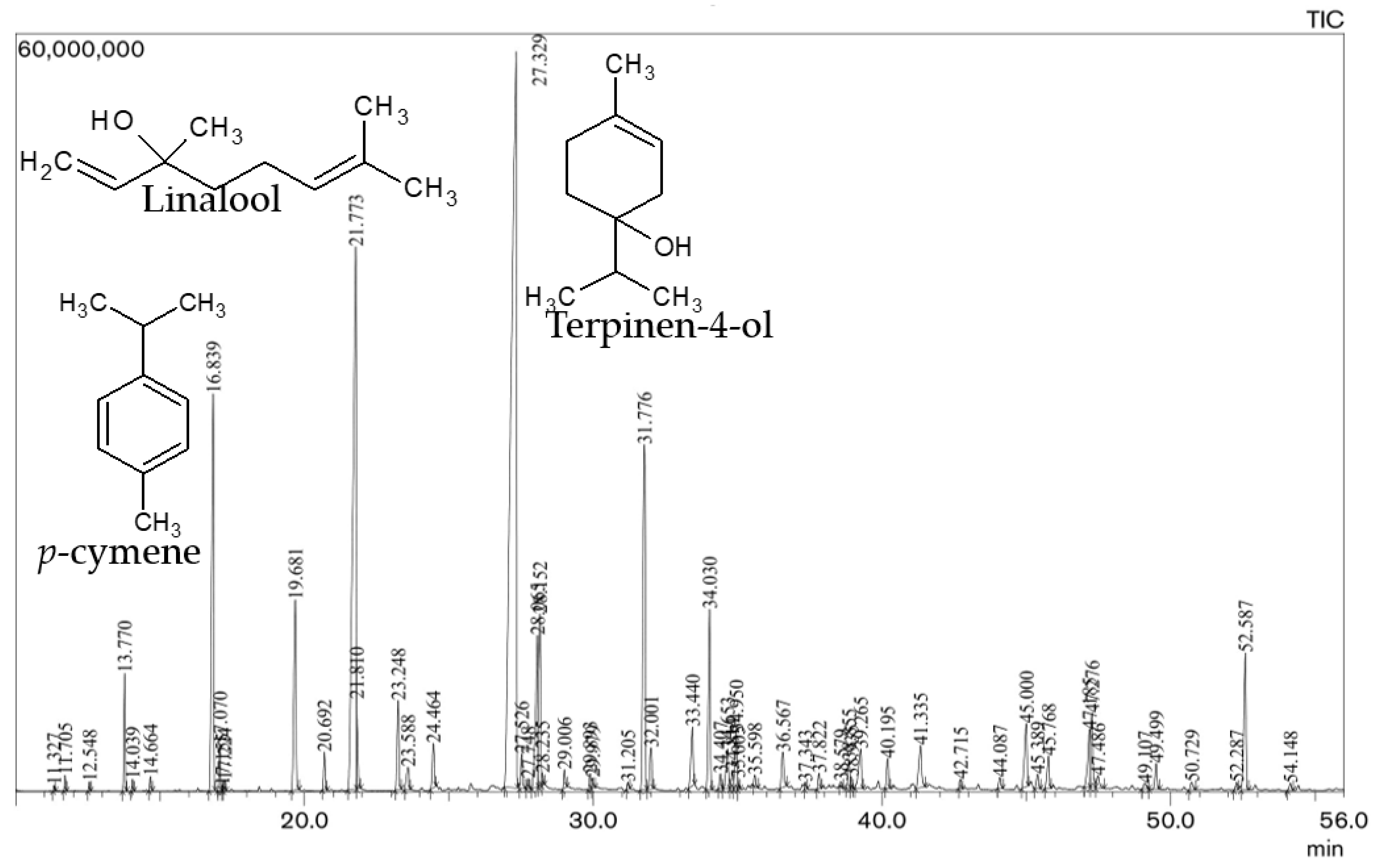
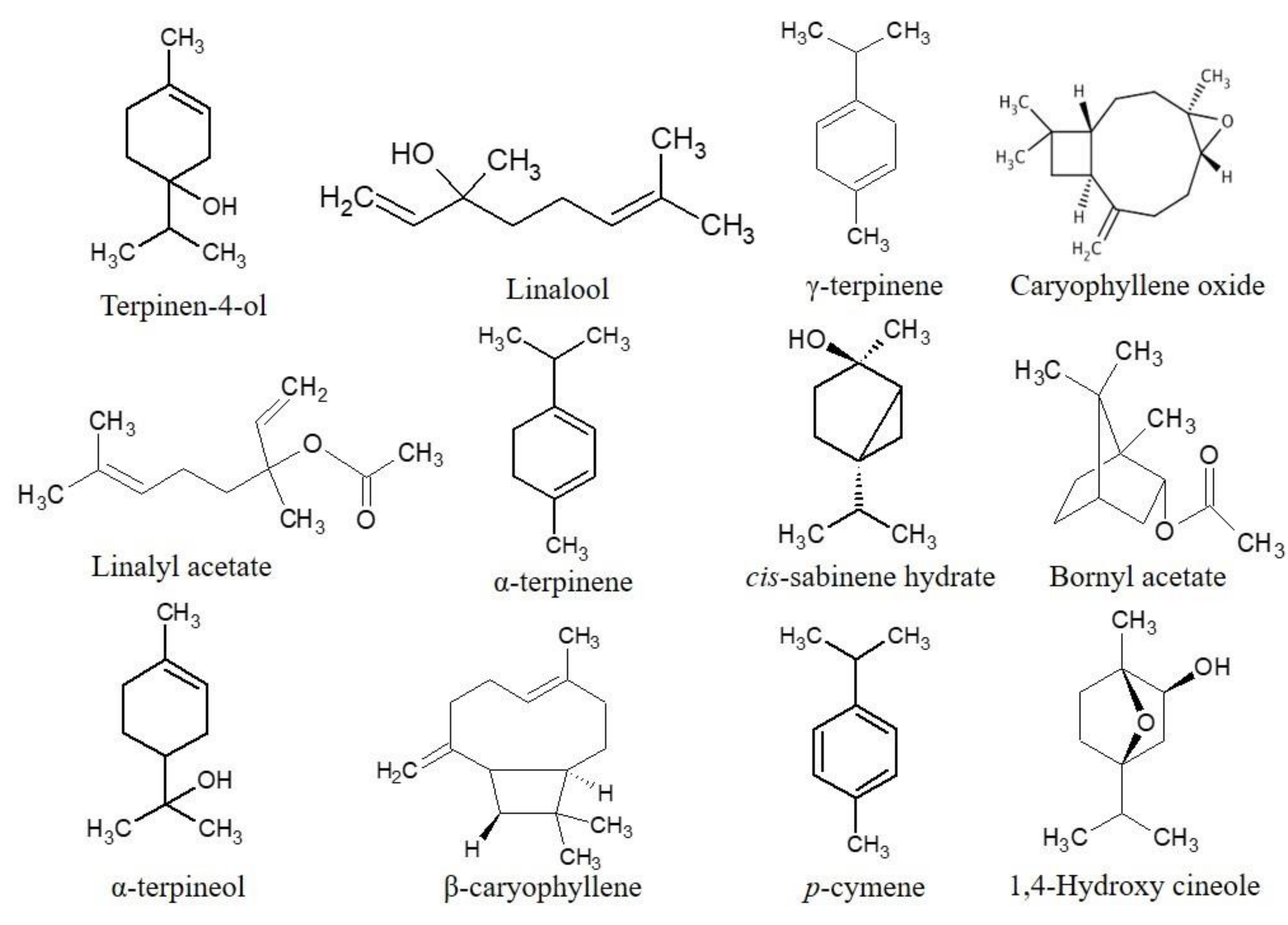
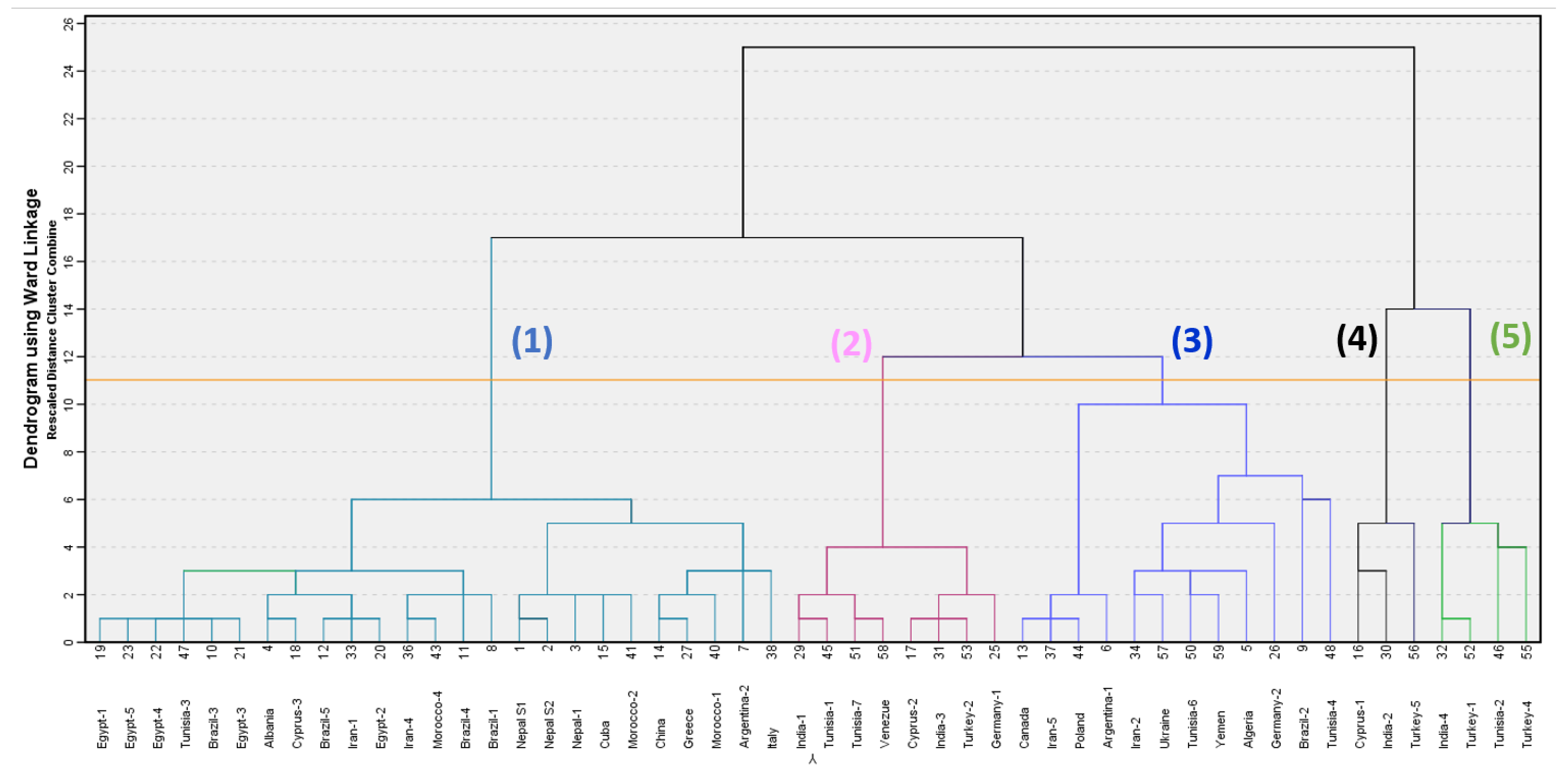
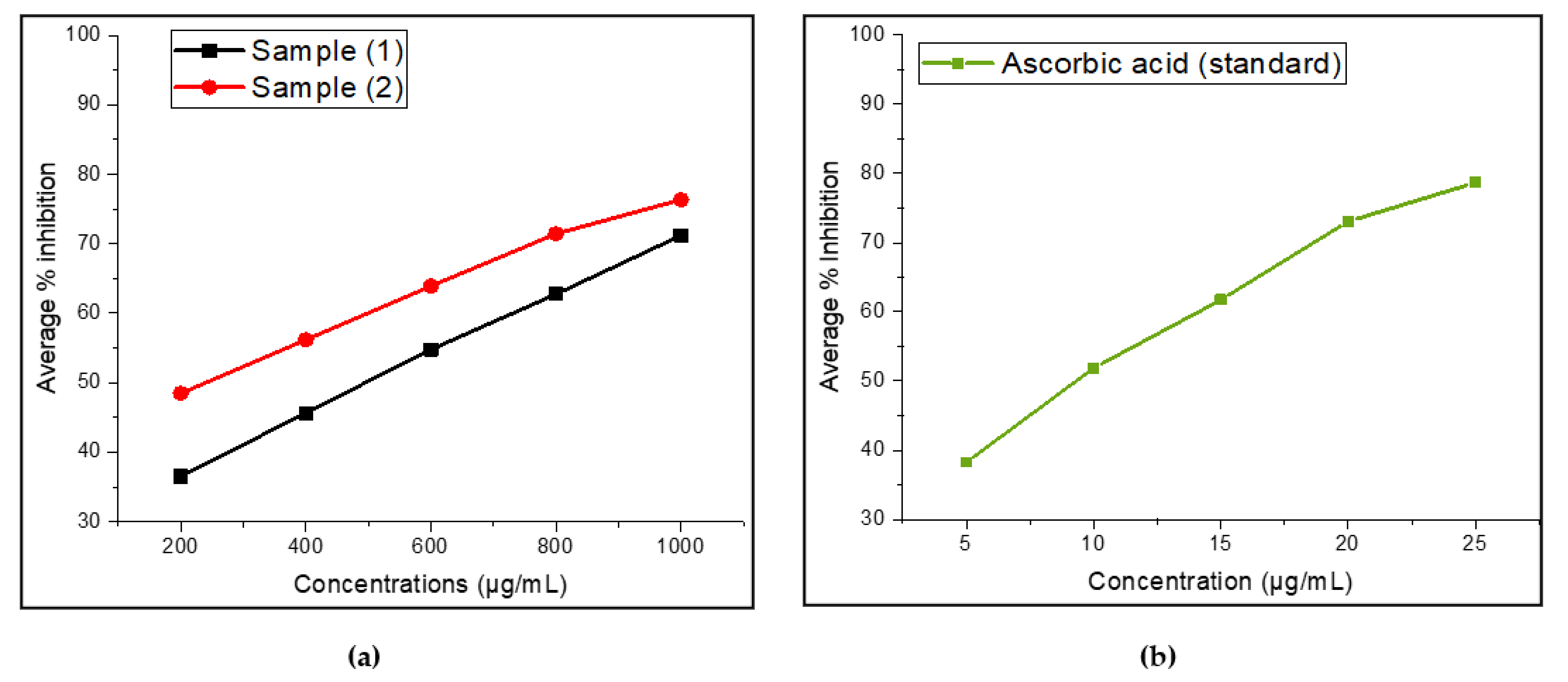
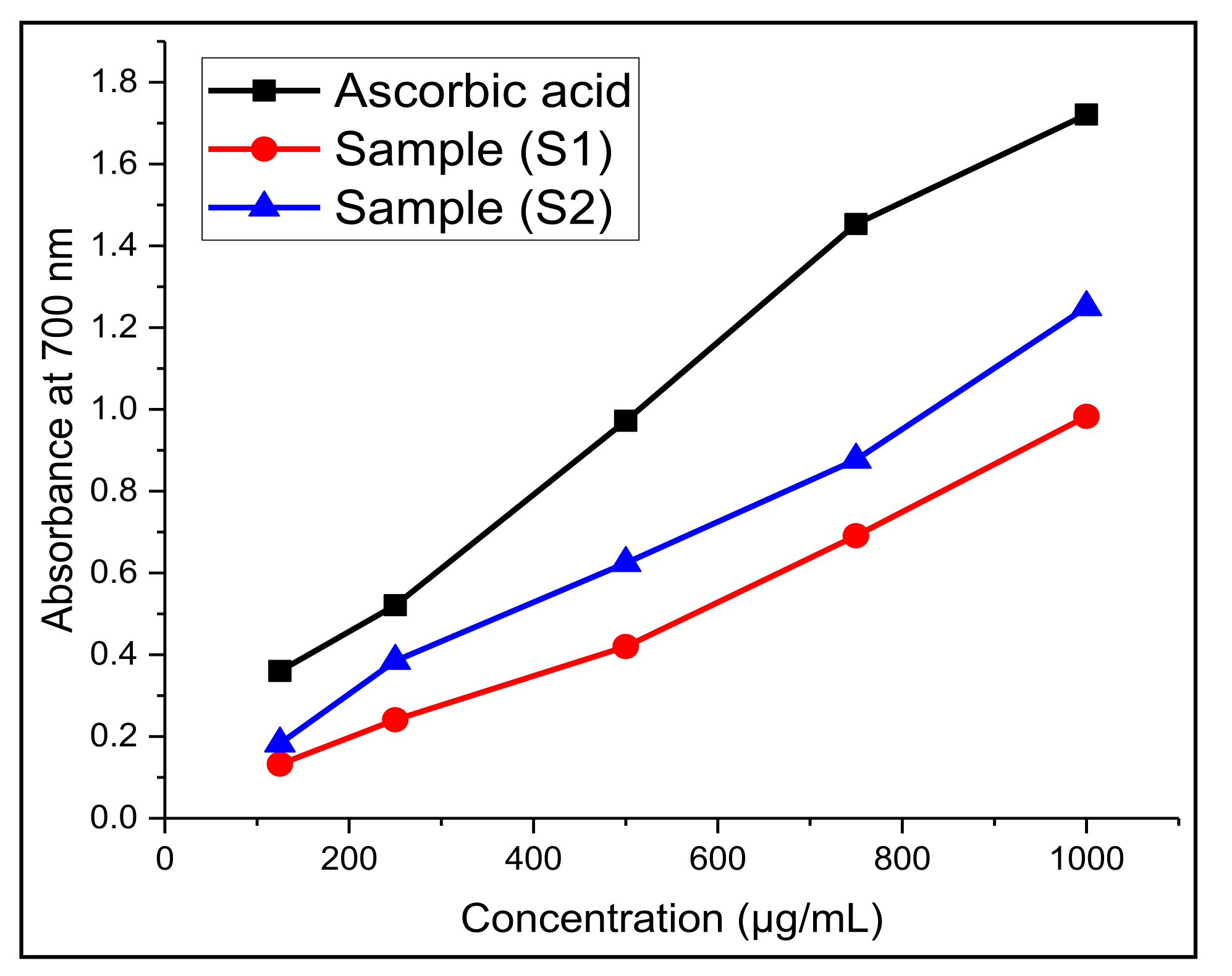
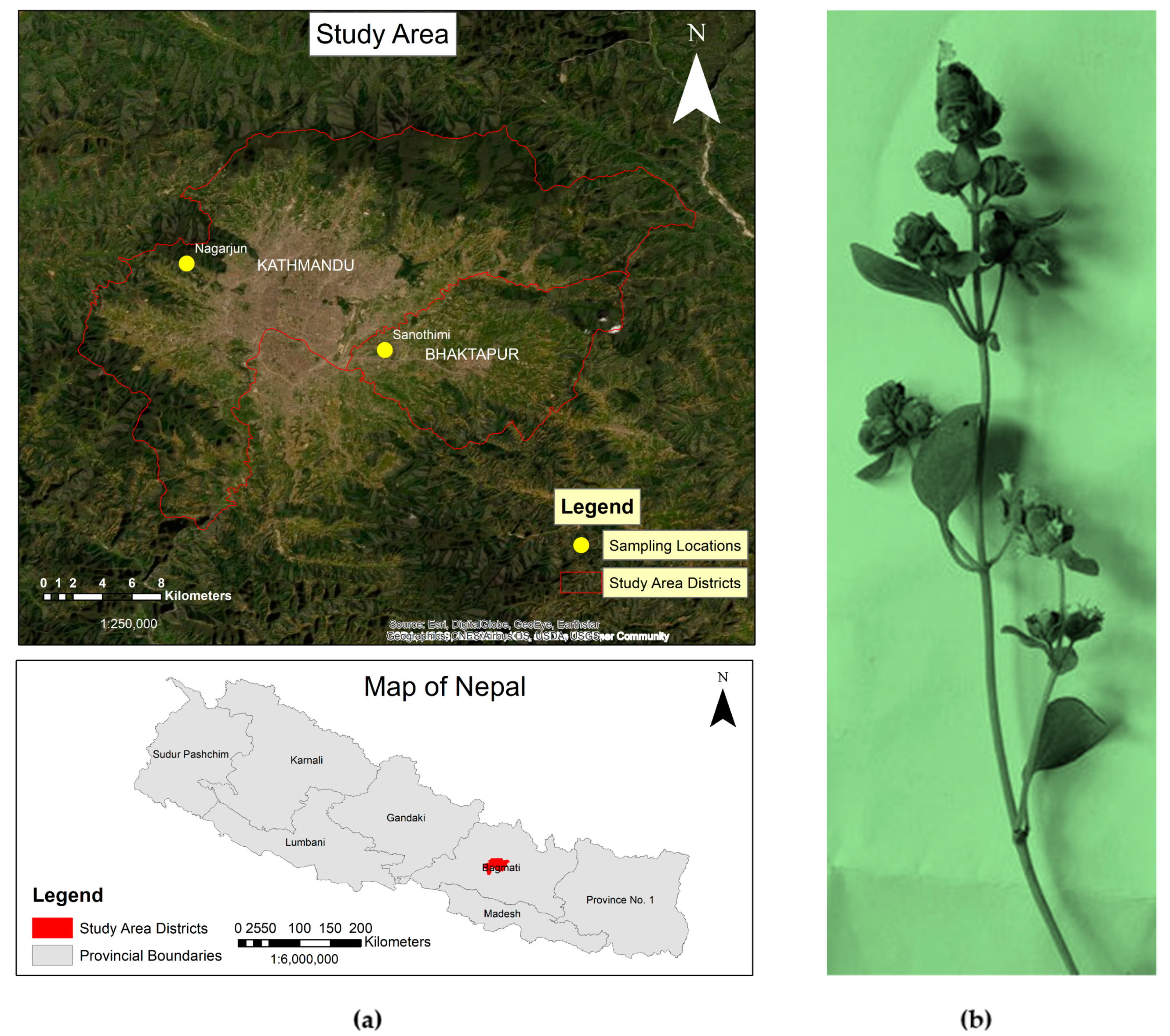
| Compounds | O. majorana (Sample S1) | O. majorana (Sample S2) | ||
|---|---|---|---|---|
| + (D) | – (L) | + (D) | – (L) | |
| α-Pinene | 55.81 | 44.19 | 50.81 | 49.2 |
| Camphene | 2.31 | 97.87 | 3.18 | 96.8 |
| Sabinene | 95.63 | 4.37 | 91.6 | 8.4 |
| β-Pinene | 24.31 | 75.69 | 29.3 | 70.7 |
| Limonene | 66.48 | 33.52 | 66.82 | 33.2 |
| cis-Sabinene hydrate | 88.52 | 11.48 | 86.8 | 13.2 |
| Linalool | 31.43 | 68.57 | 29.6 | 70.4 |
| Terpinen-4-ol | 58.31 | 41.69 | 52.6 | 47.4 |
| Linalyl acetate | 0.0 | 100.0 | 0.0 | 100.0 |
| Bornyl acetate | 0.0 | 100.0 | 0.0 | 100.0 |
| α-Terpineol | 75.3 | 24.7 | 72.4 | 27.6 |
| β-Caryophyllene | 0.0 | 100.0 | 0.0 | 100.0 |
| Name of Micro-Organism | MICs (µg/mL) | |
|---|---|---|
| EO Sample (S1) | EO Sample (S2) | |
| Bacillus cereus (ATCC 14579) | 312.5 | 312.5 |
| Staphylococcus aureus (ATCC 29213) | 312.5 | 156.3 |
| Staphylococcus epidermidis (ATCC 14990) | 312.5 | 312.5 |
| Aspergillusniger (ATCC 16888) | 156.3 | 78.1 |
| Candida albicans (ATCC 18804) | 156.3 | 78.1 |
| Trichophytonmentagrophytes (ATCC 18748) | 156.3 | 156.3 |
| Aspergillusfumigatus (ATCC 96918) | 312.5 | 156.3 |
| Cryptococcus neoformans (ATCC32045) | 312.5 | 312.5 |
| Microsporumcanis (ATCC11621) | 312.5 | 312.5 |
| Microsporumgypseum (ATCC24102) | 312.5 | 312.5 |
| Trichophytonrubrum (ATCC28188) | 312.5 | 312.5 |
| Samples and Standard | DPPH Radical Scavenging IC50 Value (µg/mL) | FRAP EC50 Value (µg/mL) |
|---|---|---|
| O. majorana (S1) | 503.08 ± 0.06 | 511.43 ± 0.61 |
| O. majorana (S2) | 225.61 ± 0.05 | 372.72 ± 0.84 |
| Ascorbic acid | 9.74 ± 0.07 | 217.23 ± 0.34 |
Publisher’s Note: MDPI stays neutral with regard to jurisdictional claims in published maps and institutional affiliations. |
© 2022 by the authors. Licensee MDPI, Basel, Switzerland. This article is an open access article distributed under the terms and conditions of the Creative Commons Attribution (CC BY) license (https://creativecommons.org/licenses/by/4.0/).
Share and Cite
Paudel, P.N.; Satyal, P.; Satyal, R.; Setzer, W.N.; Gyawali, R. Chemical Composition, Enantiomeric Distribution, Antimicrobial and Antioxidant Activities of Origanum majorana L. Essential Oil from Nepal. Molecules 2022, 27, 6136. https://doi.org/10.3390/molecules27186136
Paudel PN, Satyal P, Satyal R, Setzer WN, Gyawali R. Chemical Composition, Enantiomeric Distribution, Antimicrobial and Antioxidant Activities of Origanum majorana L. Essential Oil from Nepal. Molecules. 2022; 27(18):6136. https://doi.org/10.3390/molecules27186136
Chicago/Turabian StylePaudel, Prem Narayan, Prabodh Satyal, Rakesh Satyal, William N. Setzer, and Rajendra Gyawali. 2022. "Chemical Composition, Enantiomeric Distribution, Antimicrobial and Antioxidant Activities of Origanum majorana L. Essential Oil from Nepal" Molecules 27, no. 18: 6136. https://doi.org/10.3390/molecules27186136
APA StylePaudel, P. N., Satyal, P., Satyal, R., Setzer, W. N., & Gyawali, R. (2022). Chemical Composition, Enantiomeric Distribution, Antimicrobial and Antioxidant Activities of Origanum majorana L. Essential Oil from Nepal. Molecules, 27(18), 6136. https://doi.org/10.3390/molecules27186136









